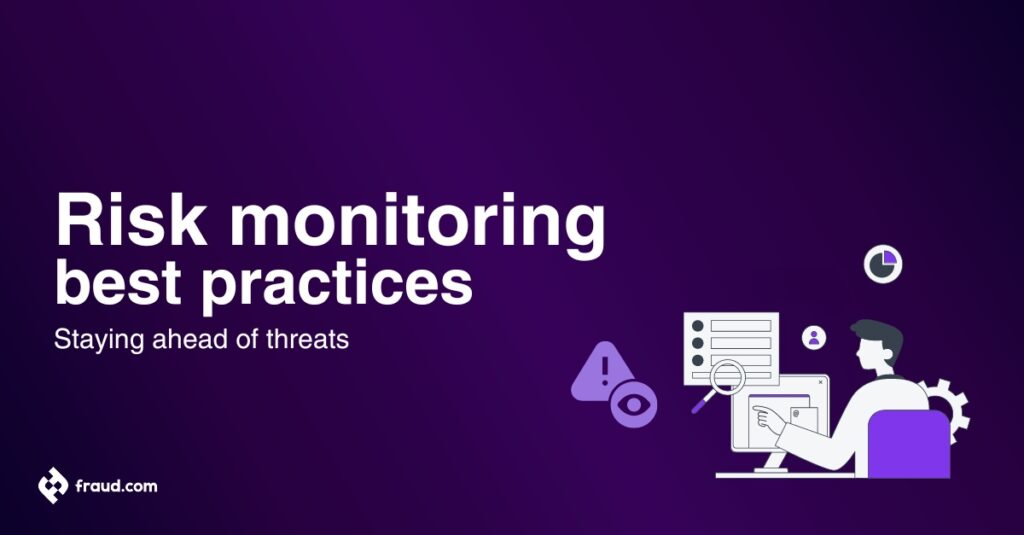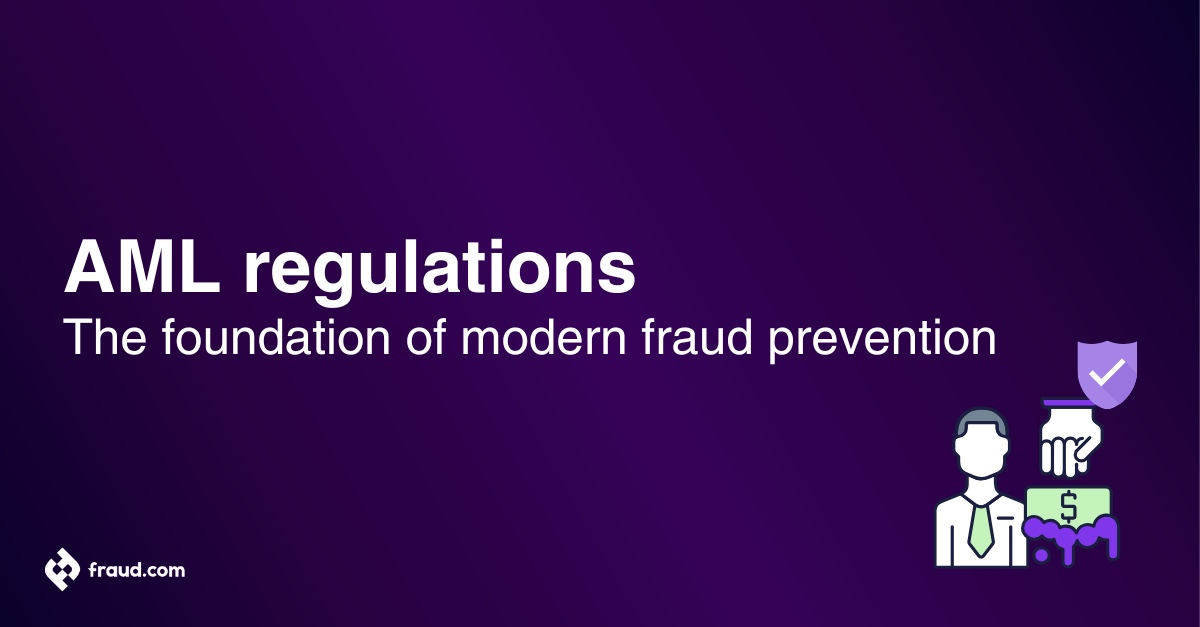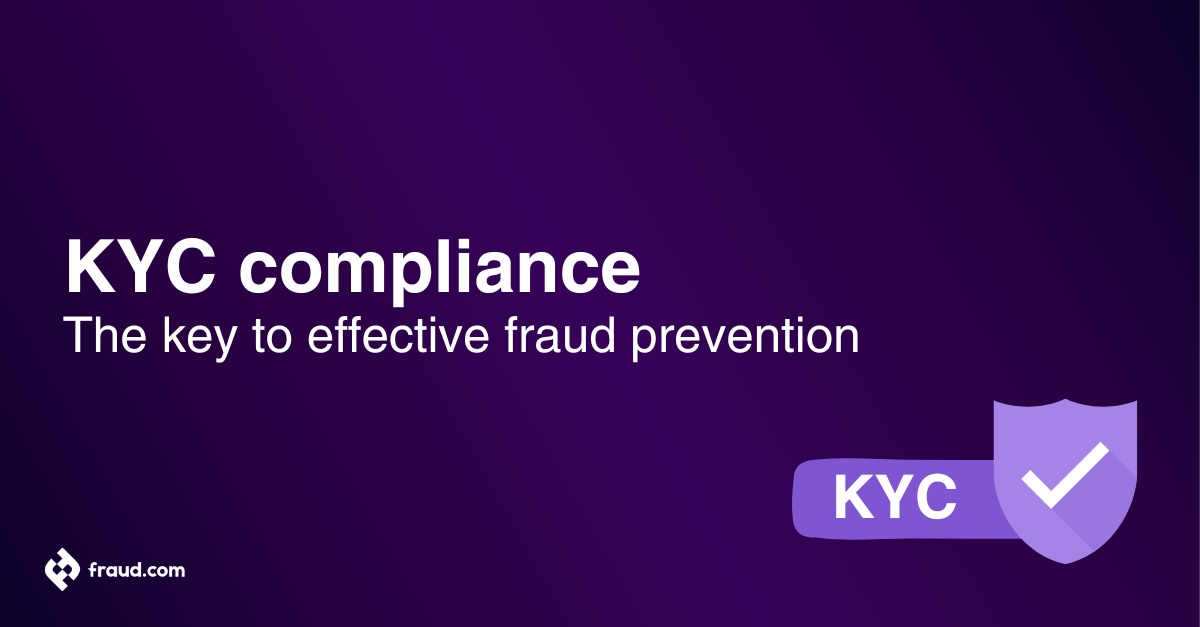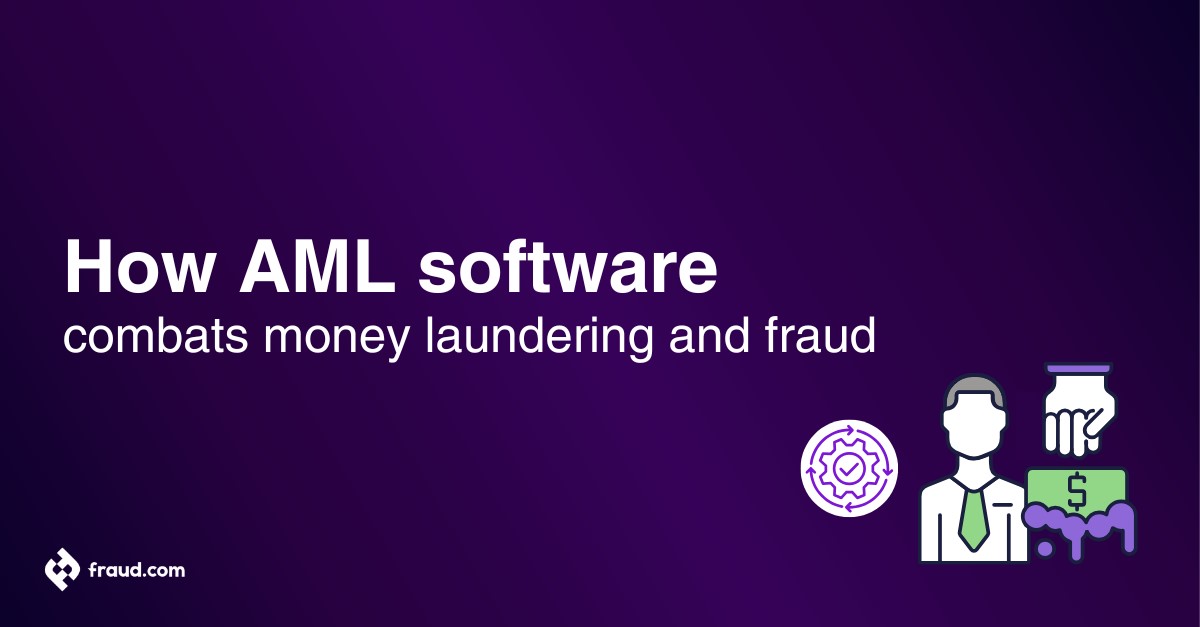With cyber threats and fraud growing more sophisticated and frequent, effective risk monitoring is essential for any organization aiming to safeguard its assets and reputation. Implementing best practices in risk monitoring allows businesses to proactively identify and mitigate potential threats, ensuring resilience and stability.
This article delves into the most efficient risk monitoring strategies, offering insights on how to stay ahead of emerging threats and maintain a robust security posture. Whether you’re an industry veteran or new to the field, understanding these practices will enhance your ability to protect your organization against an ever-changing threat landscape.
Table of Contents
ToggleWhat is risk monitoring?
Risk monitoring is a continuous process of identifying, assessing, and tracking potential threats that could impact an organization’s operations, assets, or reputation. It involves the systematic observation and evaluation of risk factors and the effectiveness of risk mitigation measures. By maintaining a vigilant watch on the internal and external environments, organizations can promptly detect anomalies, vulnerabilities, and emerging threats, enabling them to take swift and informed actions to mitigate risks.
Different types of risk monitoring
Risk monitoring is essential for maintaining organizational integrity and security. Here’s a brief look at key types of risk monitoring:
Voluntary risk monitoring: Voluntary risk monitoring is initiated by organizations themselves. It reflects a proactive approach to identify and mitigate risks, fostering a culture of vigilance and preparedness.
Mandatory risk monitoring: Mandatory risk monitoring is required by laws or regulatory bodies. Compliance ensures essential safeguards are in place and maintains public trust in the organization’s commitment to legal and ethical standards.
Reassessment risk monitoring: Reassessment risk monitoring involves regularly evaluating previously identified risks. This ensures risk management strategies stay effective and relevant amidst changes in the internal or external environment.
Continual risk monitoring: Continual risk monitoring is an ongoing, real-time process. Advanced technologies provide constant surveillance and immediate alerts, helping to identify and address risks as they emerge.
Each type of risk monitoring plays a vital role in a comprehensive risk management strategy, helping organizations protect against potential threats and ensure long-term success.
Key components of risk monitoring
- Identification of risks: This involves recognizing potential risks that could affect the organization. These risks can be internal, such as operational inefficiencies, or external, such as cyber-attacks, market fluctuations, or natural disasters. Industry-specific risks should also be identified to ensure a comprehensive understanding of all potential threats.
- Risk assessment: Once identified, risks need to be evaluated to understand their potential impact and likelihood. This helps prioritize which risks require immediate attention and resources, specifically those that could have the most significant effect on the organization.
- Risk management plan: A risk management plan outlines the strategies and processes for addressing identified risks. This plan includes risk assessment results, mitigation strategies, and roles and responsibilities. It serves as a roadmap for managing risks effectively and ensuring a structured approach to risk monitoring.
- Continuous monitoring: Regular and ongoing surveillance of risk factors is crucial. This can be achieved through automated systems that provide real-time data and alerts, as well as periodic reviews and audits. Continuous monitoring ensures that emerging risks are detected promptly.
- Incident response and management: Having a robust incident response plan is essential for addressing risks that materialize into actual incidents. This involves predefined protocols to manage and mitigate the impact of such incidents, ensuring a quick and effective risk response.
- Reporting and communication: Effective communication channels should be established to report risk findings to relevant stakeholders promptly. Transparent reporting ensures that everyone is informed and can participate in risk management strategies, enhancing collective response efforts.
- Review and improvement: The risk monitoring process should be dynamic, incorporating lessons learned from past incidents and continuously improving strategies to stay ahead of new and evolving threats. Regular reviews help refine risk management practices and enhance overall effectiveness.
Implementing a comprehensive risk monitoring framework not only helps in mitigating potential threats but also enhances an organization’s ability to make strategic decisions, optimize resource allocation, and maintain stakeholder confidence.
The role of risk monitoring in effective risk management
Risk monitoring is crucial for any effective risk management strategy. It helps identify, assess, and mitigate risks, enabling organizations to respond proactively to potential threats. Here’s how risk monitoring enhances risk management:
- Early threat detection: Continuous monitoring allows organizations to spot potential threats early, enabling timely interventions that prevent minor issues from becoming major crises.
- Informed decision-making: Providing real-time data and insights, risk monitoring helps decision-makers make smart choices, leading to better strategic planning and resource allocation.
- Boosting preparedness and response: Risk monitoring aids in developing and refining incident response plans, allowing businesses to tailor their strategies to effectively minimize downtime and disruptions.
- Ensuring compliance and governance: Ongoing monitoring helps organizations stay compliant with regulatory requirements, avoiding legal penalties and maintaining good standing with regulatory bodies.
- Optimizing resource allocation: Understanding the risk landscape allows for efficient resource allocation, focusing on high-priority areas and avoiding overinvestment in low-risk areas.
- Fostering a risk-aware culture: Consistent monitoring promotes a culture of risk awareness, making employees more attuned to potential risks and their roles in mitigating them.
- Improving stakeholder confidence: Transparent risk monitoring reassures stakeholders of the organization’s commitment to security and stability, boosting investor confidence, customer trust, and overall reputation.
- Facilitating continuous improvement: Regularly reviewing and updating risk management practices based on monitoring outcomes allows organizations to continuously improve their resilience and adaptability.
Risk monitoring methods and tools
Keeping tabs on potential risks involves using a variety of methods and tools designed to detect, assess, and manage potential threats. These methods and tools help organizations maintain a thorough and proactive approach to risk management. Here are some key strategies and tools used in risk monitoring:
Methods of risk monitoring
Continuous monitoring: Continuous monitoring collects and analyzes data in real-time from various sources within the organization. This helps detect anomalies and potential risks as they happen, allowing for immediate intervention.
Periodic audits and assessments: Regular audits and assessments evaluate the effectiveness of existing risk management controls and identify new risks. These can be scheduled (e.g., quarterly or annually) or triggered by specific events or thresholds.
Risk indicators and metrics: Key Risk Indicators (KRIs) and other metrics quantify and track risk levels. These indicators provide early warning signs of potential issues and help measure the effectiveness of risk management strategies.
Scenario analysis and stress testing: These methods simulate various risk scenarios and assess their potential impact on the organization. Scenario analysis and stress testing help understand vulnerabilities and prepare for adverse events.
Incident reporting systems: Implementing systems for reporting and documenting incidents ensures that all risk-related events are captured and analyzed. This information is vital for improving risk management processes and preventing future occurrences.
Fraud risk assessments: Conducting specific fraud risk assessments to identify and evaluate the risk of fraud within the organization. This involves analyzing processes, transactions, and controls to detect vulnerabilities that could be exploited for fraudulent activities.
Tools for risk monitoring
Security Information and Event Management (SIEM) systems: SIEM systems collect and analyze security-related data from various sources in real-time. They provide comprehensive visibility into the organization’s security posture and help identify and respond to potential threats quickly.
Risk management software: Integrated risk management platforms offer tools for tracking, analyzing, and reporting on risks. These platforms often include features for risk assessment, incident management, and compliance tracking.
Network monitoring tools: These tools continuously monitor network traffic to detect unusual patterns or potential intrusions. Network monitoring tools are essential for identifying cyber threats such as malware, phishing attacks, and unauthorized access.
Vulnerability scanners: Vulnerability scanning tools identify and assess vulnerabilities in an organization’s systems and applications. Regular scans help ensure that weaknesses are addressed promptly, reducing the risk of exploitation.
Threat intelligence platforms: These platforms gather and analyze threat data from multiple sources, providing insights into emerging threats and attack vectors. Threat intelligence helps organizations stay informed about the latest risks and adjust their defenses accordingly.
Compliance management tools: Tools designed for compliance management help organizations track regulatory requirements and ensure adherence to industry standards. These tools often include features for auditing, reporting, and managing compliance-related risks.
Business Continuity Management (BCM) tools: BCM tools aid in developing and managing business continuity plans. They ensure that critical functions can continue during and after a disruptive event, thereby mitigating operational risks.
Automated alerts and notifications: Automated alert systems notify relevant stakeholders of potential risks or incidents in real-time. These alerts enable quick response and mitigation efforts, minimizing the impact of identified risks.
Fraud detection systems: These systems use advanced analytics and machine learning to identify suspicious activities and transactions indicative of fraud. By analyzing patterns and anomalies, fraud detection systems can flag potential fraudulent activities for further investigation.
By leveraging a combination of these methods and tools, organizations can establish a robust risk monitoring framework. This comprehensive approach ensures that risks are identified and managed effectively, enhancing the overall security and resilience of the organization.
The impact of risk monitoring on organizations
Effective risk monitoring is crucial for robust risk management and significantly benefits organizations by tracking and addressing potential threats:
Enhanced decision-making: Risk monitoring provides critical data on potential threats, enabling informed decisions and better resource prioritization, helping organizations navigate uncertainties confidently.
Improved compliance and reputation: Regular risk monitoring ensures compliance with laws and standards, avoiding legal penalties and enhancing the organization’s reputation, thereby fostering trust among stakeholders.
Cost savings: Proactive risk identification and mitigation save money by preventing costly damage control, legal fees, and fines, while optimizing resource allocation and operational costs.
Increased operational efficiency: Risk monitoring reveals inefficiencies, allowing companies to streamline operations, boost productivity, and reduce costs, thus enhancing overall performance and competitiveness.
Strengthened customer and stakeholder confidence: Organizations with strong risk management practices build trust with customers and stakeholders, leading to increased loyalty and new business opportunities.
Long-term sustainability: Ongoing risk assessment and management help organizations adapt to market changes and emerging threats, ensuring resilience and sustained success in a dynamic environment.
In summary, risk monitoring is essential for thriving in today’s complex landscape, paving the way for a secure and prosperous future through improved decision-making, compliance, cost savings, efficiency, and stakeholder confidence.
Risk monitoring enhanced by fraud.com
Fraud.com enhances risk monitoring through innovative solutions like aiReflex and fcase.
aiReflex leverages artificial intelligence to provide real-time fraud detection, enabling organizations to swiftly identify and mitigate potential threats. Its advanced analytics and machine learning algorithms continuously learn and adapt to new risk patterns, ensuring robust protection against evolving threats.
fcase is a comprehensive case management platform that streamlines incident response and management. It integrates with existing systems to centralize data, automate workflows, and facilitate effective communication among stakeholders. By enhancing the efficiency and coordination of risk response efforts, fcase ensures that organizations can manage incidents promptly and effectively.
Together, aiReflex and fcase empower organizations with cutting-edge tools for proactive and efficient risk monitoring, safeguarding their operations and enhancing their resilience against potential threats.
Risk monitoring FAQs
What is risk monitoring?
Risk monitoring involves continuously tracking and evaluating potential threats to an organization. It helps in identifying, assessing, and mitigating risks to prevent adverse impacts on business operations.
Why is risk monitoring important?
Effective risk monitoring allows organizations to detect issues early, make informed decisions, comply with regulations, save costs, and maintain operational efficiency. It also builds trust with stakeholders and ensures long-term sustainability.
What are the key methods of risk monitoring?
Key methods include continuous monitoring, periodic audits, risk indicators and metrics, scenario analysis, stress testing, incident reporting systems, and fraud risk assessments. These methods provide comprehensive insights into potential threats.
What tools are used in risk monitoring?
Common tools include Security Information and Event Management (SIEM) systems, risk management software, network monitoring tools, vulnerability scanners, threat intelligence platforms, compliance management tools, business continuity management tools, automated alerts, and fraud detection systems.
How does risk monitoring enhance decision-making?
By providing critical data and insights on potential threats, risk monitoring enables better-informed decisions. Leaders can prioritize resources effectively and take preemptive actions, helping the organization navigate uncertainties with confidence.
How can risk monitoring improve compliance?
Regular risk monitoring ensures adherence to laws, regulations, and industry standards. This helps organizations avoid legal penalties and enhances their reputation, fostering trust among customers and stakeholders.
What are the cost benefits of risk monitoring?
Proactively identifying and mitigating risks prevents costly damage control, legal fees, and fines. It also leads to more efficient resource allocation, optimizing operational costs and saving money.
How does risk monitoring increase operational efficiency?
By uncovering inefficiencies and areas for improvement, risk monitoring helps streamline operations, enhance productivity, and reduce costs, bolstering the organization’s competitive edge.
How does risk monitoring build stakeholder confidence?
Organizations with strong risk monitoring practices demonstrate a commitment to security, compliance, and preparedness. This reassures customers and partners, leading to increased loyalty and new business opportunities.
How does risk monitoring ensure long-term sustainability?
Continuous risk assessment and management enable organizations to adapt to changing market conditions, technological advancements, and emerging threats, ensuring resilience and sustained success.
In summary, understanding the fundamentals of risk monitoring through these FAQs highlights its critical role in safeguarding an organization’s assets, operations, and future growth.









